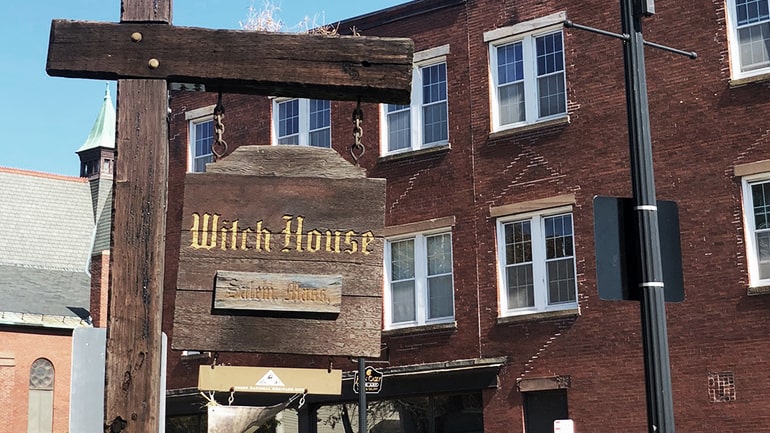This, the 117th episode of CS is titled, “Which Witch?” and is a brief review of the well-known but poorly understood Salem Witch Trials.
They’re often brought up by critics of Christianity as examples of religious intolerance and superstition. And while they did indeed carry a bit of that, they were far more a case of a breakdown in the judicial system. The phrase “witch-hunt” refers to an attempt to find something damning in an otherwise innocent victim. What’s rarely mentioned is that while there was a brief flurry of witch-hunting that went on in the New England colonies, it was a long practice in Europe from the mid-15th thru mid-18th Cs. It reached its peak in the about fifty-year span from between 1580 and 1630. It’s difficult to sort out how many were executed but scholars say it was from a low of 40,000 to as high as 60,000.
In light of such large numbers, the twenty executed in the Salem Trials seems trivial. But that even a single person was executed on the charge of witchcraft was a travesty of justice.
Witch hunts began in the 15th C in southeast France and western Switzerland. The European witch craze was fueled by the publication of The Hammer of the Witches in 1486, by the inquisitors Heinrich Kramer and Jacob Sprenger.
The trials included men and women of all ages and classes.
In New England, there’d been three hangings for witchcraft prior to Salem. But the first sign of trouble in Salem Village occurred during the winter of 1692, when Elizabeth Parris the nine-year-old daughter of the village pastor and her eleven-year-old cousin Abigail Williams, began displaying bizarre behavior. The girls screamed uncontrollably, hurled items, groaned, and threw fits of wild contortions. Witchcraft immediately surfaced as a possible explanation.
Suspicion quickly centered on three women living on the margins of village life. One was a homeless woman named Sarah Good. Another was an infrequent church-attender and so obviously suspicious woman named Sarah Osborne. The third was Tituba, a slave known for fortune-telling. These three were interrogated in March, 1692 and sentenced to jail.
Tituba’s ethnic origins are difficult to sort out but she appears to have been an African slave brought from the Caribbean to serve in the home of Pastor Samuel Parris, Elizabeth’s father. She regaled the young girls with tales of the occult and indulged their desire to have their fortunes read. When the girls were caught gazing into a crystal ball, they tried to shift blame by affecting bizarre behavior that made them appear victims of spells cast on them by something malevolent or better, some-one.
For anyone’s who’s worked with adolescent girls likely knows, it didn’t take long before others of their age saw all the attention this gained them. So they affected similar behavior to get a slice of the attention pie. They accused the soft targets of women already considered odd and suspicious. Tituba was the first to be accused, but soon Sarah Good and Sarah Osborne were also implicated, questioned, and remanded to custody.
Making matters more complicated was a long-running feud between the Putnam and Porter families. Charges and counter-charges of the damning charge of devil-worship flew on both sides. Pastor Parris used his pulpit to fan the flames of superstition that ANYONE in Salem might in fact be in league with Satan.
In March, several more women were accused. Then, anyone who questioned the girl’s veracity was suspected. Sarah Good’s four-year-old daughter Dorothy was arrested and interrogated.
Accusations began pouring in. More arrests made. But now many of those arrested weren’t just on the fringe of Salem village life. They were upstanding members of the community and church. As tension grew, Governor William Phips set up a special court to adjudicate the cases.
The first to be brought to trial was Bridget Bishop, who was accused of being a witch because her immoral lifestyle and affinity for darks clothes suggested she was in league with hell. She was found guilty and was executed by hanging in June, 1692. Five more women were executed in July, and then four men and one woman in August. The last executions took place in September when six women and three men were hung.
Some of those arrested confessed they had practiced witchcraft, and accused others of being their mentors. But scholars now believe these confessions were made under duress and with the promise that by implicating others they might be allowed to go free.
Giles Corey, an eighty-year-old farmer and husband of one of the accused, was also arrested in September. Corey refused to cooperate with the authorities and was subjected to a form of torture in which the subject is placed beneath an increasingly heavy load of stones in an attempt to compel him to enter a plea. After two days, Corey died without confessing.
The last trial occurred at the end of April, and all five accused were found not guilty, bringing an end to the episode. In the final count, twenty were hung, one was crushed to death, and four died in prison.
Twenty years later, the Massachusetts court declared the entire ordeal had been a gross injustice and ordered indemnifications be paid to the victims’ families.
At the time, two of New England’s most influential leaders were the father and son, Increase and Cotton Mather. Increase, who became president of Harvard, believed in the reality of witchcraft and has been blamed for much of what happened in Salem. But he severely criticized the proceedings and use of spectral evidence which was central to the case.
Spectral evidence was the testimony of the young girls and their supporters who claimed they saw certain things that must mean the accused were in fact witches bent on the spiritual and social unraveling of the Salem community. They saw what they described as ghost-like images. Increase Mather decried the use of such spectral evidence as being inappropriate to condemn someone to death. His son Cotton took a similar position, first writing against witchcraft, then deploring the manner in which the trials were conducted.
It was the two-fold whammy of the Mather’s condemnation of spectral evidence and that the girls apparently began to stretch out a bit to see just what they could get away with that moved people to begin to wonder what was going on in Salem. It’s one thing to accuse oddballs and misfits of being witches. But when some of the community’s most respected members and people known for their upstanding virtue were accused à Well, maybe we’ve been played by a handful of teens.
While religious superstition fueled the panic that fired the Salem Witch Trials, it was in fact a failure of the judicial system that saw people hanged. And while Pastor Parris stirred the pot in Salem with his use of the pulpit to fuel suspicion, it was the work of two other pastors, Increase and Cotton Mather that moved the people of Salem and Massachusetts to calm down and end the trials.
We turn now in the balance of this episode to tie off the Puritanism of New England.
Within a single generation, the original Puritan vision of a City on a Hill was already dimming. A new cosmopolitanism from Europe had transformed cities like Boston. By the early 18th C, American Puritanism had split into three factions.
First there were Congregational churches, which down-played Calvinist doctrines and looked to the Enlightenment. These came to be called the “Old Lights.”
Then there were those who continued to practice the rigid Calvinism of their forebears, referred to as the “Old Calvinists.”
The third group emerged from the “Great Awakening” with its pietistic emphasis on a “new birth.” The “New Lights.”
Puritanism wasn’t static on either side of the Atlantic. It couldn’t be since their political contexts were vastly different. English Puritans were engaged in a civil war, while New England Puritans were carving a life out of a new world. Despite minor variations like the New England Halfway Covenant, the Puritan theological core remained the same. The Westminster Confession of Faith is a solid guide in identifying the theological tenets of Puritanism.
The Confession was the work of the Westminster Assembly which met from 1643-9.
The Assembly was a committee appointed by Parliament. It was charged with drawing up a new liturgy to replace the Anglican Book of Common Prayer and for implementing a new plan for church government. It met in what’s called the Lady Chapel of Westminster Abbey for the first time on July 1, 1643. Parliament appointed 121 clergy and 30 laypeople to the assembly.
It replaced the Book of Common Prayer with the Directory of Public Worship in 1645, and the 39 Articles of the Church of England were replaced by the Westminster Confession in 1646. The House of Commons returned the original draft of the Confession with instructions to add biblical proof texts. Revisions were made, and the Confession was ratified by Parliament. Two catechisms were added. The Larger Catechism (designed for instructing adults) and the Shorter Catechism (a bit easier for children) were approved in 1648.
The Church of Scotland also adopted it without amendment, satisfying compliance with the Solemn League and Covenant. Its work completed, the Westminster Assembly dissolved in 1649.

